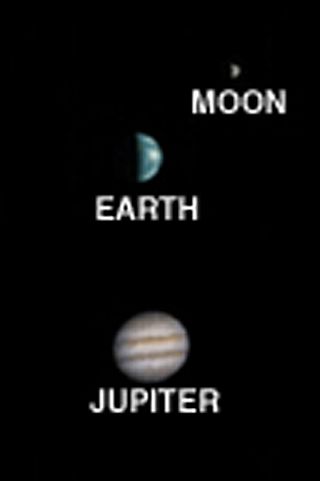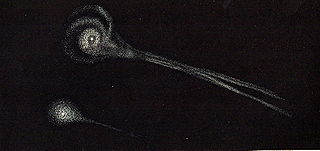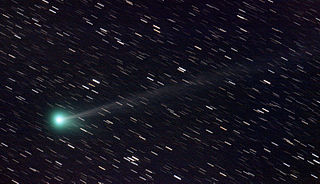
The history of astronomy focuses on the contributions civilizations have made to further their understanding of the universe beyond earth's atmosphere. Astronomy is one of the oldest natural sciences, achieving a high level of success in the second half of the first millennium. Astronomy has origins in the religious, mythological, cosmological, calendrical, and astrological beliefs and practices of prehistory. Early astronomical records date back to the Babylonians around 1000 BCE. There is also astronomical evidence of interest from early Chinese, Central American and North European cultures.

In astronomy, a conjunction occurs when two astronomical objects or spacecraft appear to be close to each other in the sky. This means they have either the same right ascension or the same ecliptic longitude, usually as observed from Earth.

The following is a timeline of Solar System astronomy and science. It includes the advances in the knowledge of the Earth at planetary scale, as part of it.
In astronomy and celestial navigation, an ephemeris is a book with tables that gives the trajectory of naturally occurring astronomical objects and artificial satellites in the sky, i.e., the position over time. Historically, positions were given as printed tables of values, given at regular intervals of date and time. The calculation of these tables was one of the first applications of mechanical computers. Modern ephemerides are often provided in electronic form. However, printed ephemerides are still produced, as they are useful when computational devices are not available.

An astronomical object, celestial object, stellar object or heavenly body is a naturally occurring physical entity, association, or structure that exists within the observable universe. In astronomy, the terms object and body are often used interchangeably. However, an astronomical body or celestial body is a single, tightly bound, contiguous entity, while an astronomical or celestial object is a complex, less cohesively bound structure, which may consist of multiple bodies or even other objects with substructures.
In ancient times, only the Sun and Moon, a few stars, and the most easily visible planets had names. Over the last few hundred years, the number of identified astronomical objects has risen from hundreds to over a billion, and more are discovered every year. Astronomers need to be able to assign systematic designations to unambiguously identify all of these objects, and at the same time give names to the most interesting objects, and where relevant, features of those objects.
The Minor Planet Center (MPC) is the official body for observing and reporting on minor planets under the auspices of the International Astronomical Union (IAU). Founded in 1947, it operates at the Smithsonian Astrophysical Observatory.

Nicole-Reine Lepaute, also erroneously known as Hortense Lepaute, was a French astronomer and human computer. Lepaute along with Alexis Clairaut and Jérôme Lalande calculated the date of the return of Halley's Comet. Her other astronomical feats include calculating the 1764 solar eclipse and producing almanacs from 1759 to 1783. She was also a member of the Scientific Académie de Béziers.

In astronomy, perturbation is the complex motion of a massive body subjected to forces other than the gravitational attraction of a single other massive body. The other forces can include a third body, resistance, as from an atmosphere, and the off-center attraction of an oblate or otherwise misshapen body.

Many astronomical phenomena viewed from the planet Mars are the same as or similar to those seen from Earth; but some are quite different. For example, because the atmosphere of Mars does not contain an ozone layer, it is also possible to make UV observations from the surface of Mars.

A lunar standstill or lunistice is when the Moon reaches its furthest north or furthest south point during the course of a month. The declination at lunar standstill varies in a cycle 18.6 years long between 18.134° and 28.725°, due to lunar precession. These extremes are called the minor and major lunar standstills.
James Whitney Young is an American astronomer who worked in the field of asteroid research. After nearly 47 years with the Jet Propulsion Laboratory at their Table Mountain Facility, Young retired July 16, 2009.
The Association of Lunar and Planetary Observers is an international scientific and educational organization established in March 1947 in the United States by Walter H. Haas, and later incorporated in 1990. ALPO is an organization for advancing and conducting astronomical work by both professional and amateur astronomers who share an interest in Solar System observations. It is currently headquartered in Springfield, Illinois.

A lost comet is one which was not detected during its most recent perihelion passage. This generally happens when data is insufficient to reliably calculate the comet's location or if the solar elongation is unfavorable near perihelion passage. The D/ designation is used for a periodic comet that no longer exists or is deemed to have disappeared.

C/2009 R1 (McNaught), one of more than fifty comets known as Comet McNaught, is a non-periodic comet discovered by British-Australian astronomer Robert H. McNaught on September 9, 2009, using the Uppsala Southern Schmidt Telescope at Siding Spring Observatory in New South Wales, Australia. The discovery was confirmed the same day at the Optical Ground Station telescope at Tenerife. After the discovery, earlier images of the comet were found from July 20, August 1, and August 18, 2009. It is believed that C/2009 R1 has left the Solar System permanently.
This glossary of astronomy is a list of definitions of terms and concepts relevant to astronomy and cosmology, their sub-disciplines, and related fields. Astronomy is concerned with the study of celestial objects and phenomena that originate outside the atmosphere of Earth. The field of astronomy features an extensive vocabulary and a significant amount of jargon.
Maya astronomy is the study of the Moon, planets, Milky Way, Sun, and astronomical phenomena by the Precolumbian Maya civilization of Mesoamerica. The Classic Maya in particular developed some of the most accurate pre-telescope astronomy in the world, aided by their fully developed writing system and their positional numeral system, both of which are fully indigenous to Mesoamerica. The Classic Maya understood many astronomical phenomena: for example, their estimate of the length of the synodic month was more accurate than Ptolemy's, and their calculation of the length of the tropical solar year was more accurate than that of the Spanish when the latter first arrived. Many temples from the Maya architecture have features oriented to celestial events.

2018 VG18 is a distant trans-Neptunian object (TNO) that was discovered when it was 123 AU (18 billion km; 11 billion mi) from the Sun, more than three times the average distance between the Sun and Pluto. It was discovered on 10 November 2018 by Scott Sheppard, David Tholen, and Chad Trujillo during their search for TNOs whose orbits might be gravitationally influenced by the hypothetical Planet Nine. They announced the discovery of 2018 VG18 on 17 December 2018 and nicknamed the object "Farout" to emphasize its distance from the Sun.

2018 AG37 is a distant trans-Neptunian object and centaur that was discovered 132.2 ± 1.5 AU (19.78 ± 0.22 billion km) from the Sun, farther than any other currently observable known object in the Solar System. Imaged in January 2018 during a search for the hypothetical Planet Nine, the confirmation of this object was announced in a press release in February 2021 by astronomers Scott Sheppard, David Tholen, and Chad Trujillo. The object was nicknamed "FarFarOut" to emphasize its distance from the Sun.

Historical models of the Solar System first appeared during prehistoric periods and remain updated to this day.. The models of the Solar System throughout history were first represented in the early form of cave markings and drawings, calendars and astronomical symbols. Then books and written records became the main source of information that expressed the way the people of the time thought of the Solar System.